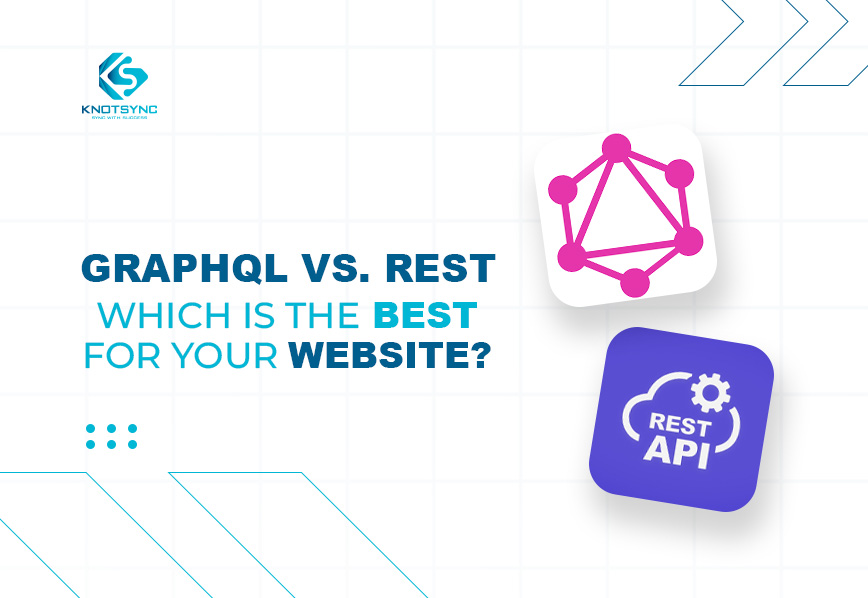Choosing the perfect technology solution depends on the specific needs of your business, so it’s necessary to understand both options before deciding. To help you understand the comparison of (GraphQL vs. REST ) these two web development technologies, think of it as a well-known analogy – GraphQL is like driving a taxi, and REST API lets you drive your own car!
Over the past decade, REST has become a universal standard (although a fuzzy one) for developing web APIs. It provides some great ideas, such as structured access to resources and stateless servers. REST APIs have proven too rigid to adapt to the client’s ever-changing needs. On the other hand, GraphQL is created in response to the demand for increased efficiency and flexibility! It addresses many developers’ drawbacks and inefficiencies while using REST APIs.
GraphQL vs REST: Differences and Features
There are two ways for web API development to exchange data over the internet – GraphQL and REST. If you’re wondering which is the best web development best practice among these two, we will explain your query with their definition and features that will help you determine which is the best choice for your website performance.
What Is GraphQL?
GraphQL is a query language, runtime, and tooling developed by Facebook in 2015. It enables clients to dictate the structure of data returned from an API, reducing the number of requests a client needs to make to display a page. With GraphQL, developers can construct a single, flexible API that returns data in a structured format. It uses a type system to define a schema, which enables the client to specify the fields it needs in a single request.
Features:
- Frontend and Backend can be separate with GraphQL
- It is independent of language and HTTP
- Since it is statically type, you don’t require to define a variable before using it
- No over-fetching or under-fetching of data
- It helps to save bandwidth
- GraqphQL documentation is provided at no additional cost.
What Is REST?
REST is a widely adopted architectural style for building web services. It relies on predefined endpoints to retrieve, create, update, or delete data. Each endpoint represents a specific resource, and REST APIs adhere to statelessness, uniform interface, and caching principles.
Features:
- REST API allows systems to transfer and receive data
- Resources are easily accessible by name.
- REST has a stable interface
- You can keep frequently used data in memory with REST.
- Its architecture and pattern are straightforward.
- A REST API endpoint can easily map database resources within an application.
- The APIs in REST can be serve from multiple servers
- REST services can be scale to meet customer demand while achieving outstanding performance.
Which Web Development Technology Is Best for Your Project GraphQL vs REST ?
While relatively new, GraphQL has earned much popularity in the web development industry. It is being adopted by many big organizations because of its revolutionary benefits for the developer experience. Conversely, REST is a robust choice for simpler applications with well-defined data structures and when caching and server-side website performance optimizations are critical. Let’s understand this by explaining it individually.
When To Use GraphQL?
GraphQL is perfect when you want more precise control over the data you fetch from the server. Because all of the requested data may be returned in a single answer, GraphQL also requires fewer requests than a REST API. Additionally, it provides more flexibility in data processing because complicated relationships between various data types may be simply queried using GraphQL.
When To Use REST?
REST API works best when you need to access massive amounts of data quickly. It’s also better when working with multiple data types because each request may be customized to deliver only the precise data required. Moreover, REST APIs are typically faster and easier to set up than GraphQL APIs because of their increased standardization and widespread usage.
Now that we have discussed GraphQL and REST in detail, it is finally time to decide which web development best practices for your project among them.
Data Control: Because GraphQL lets you ask for just what you need in a single query, it gives you more control over your data. On the other hand, REST API has less control over data because each request must be customized for the particular data being sought.
Error Handling: Since REST APIs utilize standardized protocols that are easier to monitor, they are typically superior for managing errors. They return different HTTP statuses for various phases of AP requests. Because GraphQL returns the 200 OK response for all API requests—even those that contain errors—it might be challenging to monitor issues and integrate with the tools required for monitoring.
Speed & Efficiency: REST APIs are more effective and faster because REST APIs can quickly provide vast amounts of data. Although GraphQL is also quick, it may take longer than a REST API to process complex requests for the same data.
Rapid Prototyping: GraphQL is perfect for rapid prototyping Because you can query data rapidly and receive the precise information you need in a single response. REST APIs are best for complex applications that demand more data manipulation
Setup & Maintenance: REST APIs rely on widely used standard protocols, making them easier to set up and manage. GraphQL is more complicated to set up and manage because it demands bespoke code and a GraphQL schema.
Web Cache: Web caching is unsuitable for GraphQL APIs because different data may be return for each query. On the other hand, it can be cached because the response to every request from a REST API is the same.
Bandwidth Concerns: GraphQL saves bandwidth by allowing clients to retrieve only the required data in a single query. REST APIs will use more bandwidth because they demand more requests.
The best option between GraphQL and REST APIs will depend on the demands of your business. As both are relevant in today’s web development technological environment.
Wrapping Up: GraphQL vs REST – Which Is the Ultimate Winner?
Both GraphQL and REST APIs have advantages and disadvantages and making the right choice depends on your requirements. The main reason for the rapid rise in popularity of GraphQL is its ability to prevent both over-and-under fetching. It is a terrific robust tool, typically when the software industries incorporates a complex framework and offers a better effective client-side methods of collaboration.
Simply put, GraphQL is a tool to achieve specific query-oriented objectives. It’s not a one-stop solution for all API-related challenges and certainly not a replacement for REST. If you want to improve your website performance using one of these web development best practices, visit Knotsync today!!!



